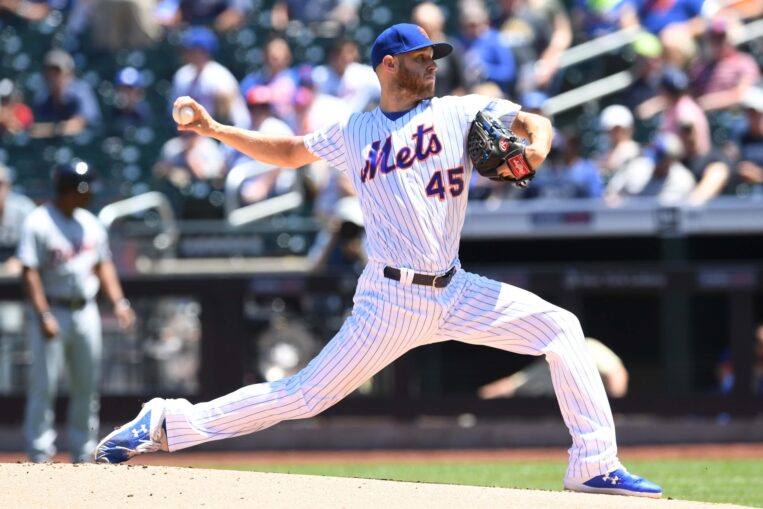
After going 12-7 with a 3.31 ERA and 1.12 WHIP last year, Zack Wheeler looked like the ace everyone thought he could become. The hard-throwing right-hander finished 2018 with a flourish, as he posted a 9-1 record and 1.68 ERA in the second half.
But Wheeler’s dominance has not carried over into 2019. He owns a 4.94 ERA through 15 starts, and he leads the National League with 52 earned runs allowed. It’s a shocking development for a pitcher as talented as Wheeler, so let’s take a deeper look into his numbers.
Fielding Independent Pitching
Given that the Mets rank last in the National League with -55 Defensive Runs Saved (DRS), Fielding Independent Pitching (FIP) is a good place to start. Since FIP takes defense out of the equation, this statistic will not penalize Wheeler for the poor fielders behind him.
Wheeler’s FIP stands at 3.83, which is nearly identical to his career mark of 3.80. Additionally, his 3.92 xFIP is also in line with his career xFIP of 3.87. These statistics suggest that Wheeler is still pitching well, but bad defense and poor luck is inflating his ERA.
Wheeler’s last two starts against the Yankees and Braves serve as a prime example of this argument. While Wheeler was not at his best in either outing, the Mets’ fielders struggled mightily in these starts.
In the fifth inning against Atlanta, for example, Wilson Ramos (-7 DRS) failed to block a pitch in the dirt which allowed runners to advance to second and third base. Later that same inning, Amed Rosario (-13 DRS) let a groundball get past him for an RBI single. Even the normally sure-handed Todd Frazier (2 DRS) made an error in Wheeler’s outing against the Yankees, and Pete Alonso (1 DRS) committed an error against the Braves.
Adding to Wheeler’s tough luck, he yielded bloop RBI singles to Gary Sanchez and Nick Markakis in these games. Given all this misfortune, it’s easy to see why Wheeler has a .319 BABIP (Batting Average on Balls in Play). And it also explains why there’s such a huge difference between Wheeler’s 4.94 ERA and his 3.83 FIP, the second largest gap in the major leagues.

Wheeler’s Elevated Homerun Rate
A major part of Wheeler’s success last season was his ability to limit home runs. His 0.69 HR/9, and his 8.1% HR/FB (Homerun to Flyball Ratio), both ranked fourth in the majors last season. But these are rates that few pitchers can maintain, especially in today’s era of juiced balls and launch angles, so it isn’t that surprising to see Wheeler’s HR/9 rise to 1.33 this year.
It’s a good sign that his flyball percentage remains similar to last year (35.8% to 35.4%). This means that the increase in home runs is mostly the result of Wheeler’s 14.3 HR/FB, which is a statistic that is often the result of luck. As FanGraphs explains, pitchers have little control over their HR/FB rate.
So simply put, a greater percentage of Wheeler’s flyballs are going for home runs, and that is more likely the result of luck, and today’s homerun happy environment, rather than an indictment on Wheeler’s ability.
A Career Best Strikeout and Walk Rate
Wheeler hasn’t lost the electric stuff that made him such a tantalizing prospect, and an excellent starter last year. The 29-year-old power pitcher still throws a blazing fastball, and he is striking out more batters than ever. Wheeler’s average fastball velocity sits at 97.3 MPH this season, which ranks behind only Noah Syndergaard in the MLB.
Wheeler’s 9.7 K/9 is the highest rate of his career. Moreover, his 2.6 BB/9 is the lowest he ever posted. A pitcher increasing his strikeouts and decreasing his walks is usually a recipe for success, so these improved rates are just more evidence that he is undeserving of a 4.94 ERA.
Final Thoughts
With better luck and improved defense behind him, Wheeler should easily post an ERA closer to his 3.83 FIP. And he still has the potential to be a top tier starter because of his excellent stuff and improving strikeout to walk ratio.
Even if one doesn’t trust the analytics, it’s obvious that Wheeler’s 4.94 ERA doesn’t reflect his true ability. It’s doubtful that a skilled pitcher in the prime of his career suddenly loses it, especially when there’s no apparent injury, or decrease in velocity.
While it’s undoubtedly been a frustrating season for Wheeler, there’s plenty of evidence to suggest that his numbers will improve down the stretch. As a free agent after this season, he will either provide value as an intriguing trade chip, or as an essential piece in the Mets’ rotation, if they hope to climb their way into playoff contention.
















